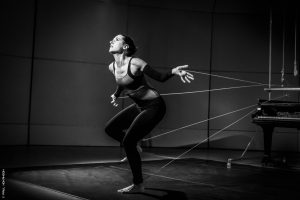
E.L. Lately, I have been reading and writing a lot about form and motion, and their ability to elicit an emotional and even aural experience in the viewer. Liaison would not be what it is without your background in dance/choreography. How did you think about the relationship between form, motion, and music in this piece?
M.A. In Liaison the motion was a result of the constraints and possibilities of the form (the structural nature of the piece) and the music a result of the motion. There are so many ways in which movement can relate to music, though movement is typically seen in the context of the music, regardless of which comes first in the creative process. I love that in Liaison the music is absolutely dependent upon the movement. The music is heard in the context of the movement!
E.L. The physicality of Liaison is a fundamental aspect of the work itself. How did you approach this ‘duet’ as opposed to one you would perform with another human body?
M.A. I approached the creations of Liaison exactly the same way I would a duet with a human, though there was a little less discussion ;). I did a physical brainstorm. I spent many rehearsals generating material in order to find what was possible. I begin a duet with a human partner by brainstorming/generating material as well.
Performing Liaison feels like a solo. I am the only one managing the movement of the strings and controlling the sound. How the piano reacts is in direct response to my choice in tension, timing and tempo. Although I do have to listen very closely to the piano and be patient with it in the same way that I would with a human partner.
E.L. One of my favorite moments watching a video of your performance at the Buffalo Infringement Festival in 2014 is the sound of your feet shifting across the floor. Were the acoustic properties of specific spaces something you and composer Megan Beugger considered during the developmental stages of this piece?
M.A. The acoustics aren’t something I considered. I assume Megan has this in mind especially with the kind of work she makes. I attended a concert of her work and some of the sounds she has the musicians making are very soft and subtle. There are times where you really have to take in the sound both visually and audibly. In Liaison, the quality of the sound was dependent on the piano, how much rosin was on the strings and the space in which we performed.
E.L. This work challenges many of the traditional perceptions of what it means to make music. How do you feel about the future of performance and emerging technologies?
M.A. I think the future of music and dance is exciting. Artists are creating new intersections of these two traditionally coupled forms. Artists are interested in finding ways for a more fluid and dynamic relationship between music and dance. The use of technology doesn’t interest me much.
E.L. Do you have a favorite Butoh artist?
M.A. My favorite artists that utilize characteristics of Butoh are Eiko and Koma, Japanese choreographic collaborators whose work utilizes designed environments and extremely slow motion movement. The intent necessary for slow motion movement has always interested me. It feels really good to move slowly for me. I enjoyed the fact that people could actually hear “slow” in Liaison.
©2016 Desert Suprematism
Melanie Aceto is a modern dancer, choreographer and educator. Her creative interests are in interdisciplinary solo and large group works. Recent projects include the creation of Cloud, a work for six dancers and 3,000 square feet of plastic, made in collaboration with architect/designer Michael Rogers, a solo for piano and dancer made in collaboration with composer Megan Beugger, and a piece for voice and dancer with Turkish composer Esin Gunduz. Melanie’s work has been performed internationally in Toronto, Guatemala and Germany and nationally at Jacob’s Pillow Dance Festival, in Las Vegas, Virginia, Kentucky, New Jersey, Florida, Pennsylvania, in Ohio as part of the Heidelberg New Music Festival and numerous venues in Rochester and Buffalo, NY including the Albright-Knox Art Gallery and the Burchfield Penney Arts Center. New York City performances include The MATA festival (The Kitchen), the Studio Museum in Harlem, REVERB dance festival (Ailey CitigroupTheater), Cool NY and D.U.M.B.O Dance Festivals (John Ryan Theater), and the American Dance Guild (Ailey CitigroupTheater).
Melanie’s research interests include investigating models for teaching dance composition and modern technique and creating resources for both. Her work has been published in the Journal of Dance Education. Melanie also has a passion for choreographic preservation. Current projects include Choreographic Lineage (www.choreographiclineage.buffalo.edu), an interactive web-based resource presenting the lineage of dance artists. Commissioned by the Dance Heritage Coalition, Melanie completed a scholarly assessment of the New York based Lar Lubovitch Dance Company detailing the current state of their archive. Melanie earned her Master of Fine Arts degree in dance from New York University’s Tisch School of the Arts and is currently an Associate Professor at the University at Buffalo teaching all levels of modern technique, improvisation and choreography.